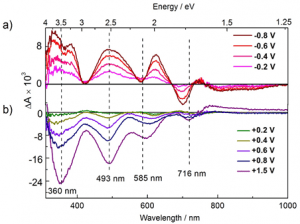NanoTransport

Overview: Novel transport phenomena emerge at nanometer scale solid-solution interface. The transport process, inhomogeneous in space and dynamic in time, is an essential step in electrochemistry, separation, energy conversion, sensing and analysis, among other science and technology disciplines. We combine experiments (electroanalytical) and simulation (continuum-theory) to gain fundamental understanding on the ion transport dynamics at interfaces confined in ordered nanostructures with broken symmetry, such as single conical nanopipettes and nanoporous membranes.
Project 1: Nucleation and Crystal Growth at Single Entity Resolutions
Crystallization of matter is one of the macroscopic phase transitions in solution that has broad relevance in chemistry, materials science, biology, pharmaceutical and other industries. For example, high quality single crystals are needed for the structure determination in basic research. They also display exciting chemical, physical and mechanical properties. Lack of capable methods to measure and to actively control the crystallization process has been a bottle neck limit to advance the fundamental research as well as practical applications. In this project, a single entity method is being developed to monitor and actively control the most challenging step in crystallization, nucleation which corresponds to the dynamic heterogeneous transitions from individual solute molecules to a crystal embryo.
Selected Ref.: Method To Directly Measure and Actively Control a Single Nucleation-Crystal Growth Process. Crystal Growth & Design 2019, 19 (4), 2470-2475.
Project 2: Unusual transport dynamics at nano-interface in desalination, ion separation and energy harvesting from salinity gradients
A key motivation of our nanotransport research is to address the challenges and opportunities summarized in the water-energy nexus framework. The impacts of the nanostructure confinements on the ion transport open new avenues to mitigate some limitations in classic wisdom, and to achieve high performance in selectivity and throughput/efficiency for the related applications.
Selected Ref.: 1. Deconvolution of electroosmotic flow in hysteresis ion transport through single asymmetric nanopipettes. Chem. Sci. 2020, 11 (23), 5950-5958. 2. Correlating Non-zero Crossing in Pinched Hysteresis Current-potential Curves with Nanogeometry and Surface Factors in Single Conical Nanopores Anal. Chem.,2017, 89 (21), 11811-11817
Metal Nanoclusters with Atomic Precisions

Overview: Metal nanoclusters (NCs) can be described by atomic compositions of MX NY (Lig1)a (Lig2)b in which x, y,… and a, b, … are discrete numbers of metal atoms (M, N …) and ligands (thiolates, halides etc.). We are interested in noble metals such Au and bimetallic ones for their electrochemical and optical properties and superb stability from application perspective, and fundamental structure-function correlations where atomically precise compositions and structures can be elucidated.
Project 1: Electrochemical properties, optical properties, electron-light-matter interactions
Basic electrochemical techniques and spectroscopic tools are used to understand the synthesized metal NCs that are ‘rationally designed or chosen’ toward specific fundamental and application needs. Spectroelectrochemisty and electrochemiluminescence (ECL), two techniques combining the power of electrochemistry and optical spectroscopy, are particularly useful for us to unveil the electronic transitions in these fascinating nanoclusters.
Project 2: Sensing and biomedical applications
Photoemission in near infrared range is highly favorable for sensing/imaging in biomatrix due to the relatively low noise/interference. ECL is activated by electron transfer reactions, further eliminating the need of a light source in i.e. fluorescence. Our mechanistic insights on the electrochemical and luminescent properties of metal NCs are exploited toward applications, in method development such as signal generation and enhanced contrast (signal/noise ratio); in tool development such as sensors; and as reagents for high contrast analysis etc.
Selected Ref.: 1. Near IR Electrochemiluminescence from Au Nanoclusters Enhanced by EDTA and Modulated by Ions ChemElectroChem, 2017, 4, 1697-1701 (Invited, Special Issue, back cover). 2. Near Infrared Electrogenerated Chemiluminescence from Aqueous Soluble Lipoic Acid Au Nanoclusters J. Am. Chem. Soc., 2016, 138 (20), 6380–6383 (JACS spotlight)
Electrochemical RNA Sensors
Overview: Many applications, particularly in the analysis of biomedical samples, require high contrast or signal-to-noise ratio due to two fundamental facts: 1. the sample of interest is often at low abundance which generally indicates low signals; and 2. noise and the presence of interference species are often inevitable. By combining redox cycling mechanism into aptamer folding based recognition, the project aims to push the detection limit (lower) toward single entities yet maintaining high specificity. Individual microelectrodes or multi-element electrode arrays are functionalized to recognize target-specific RNA sequences, which turns on the electron transfer pathway. The signal-on mechanism is highly favorable for the applications under challenging environment. The signal is further amplified by redox cycling.

The signal amplification is fundamentally different from the widely used sample amplification (i.e. PCR) mechanism, and offers practical advantages such as fast turn around time, being quantitative (in absolute concentration/amount), reducing the needs of the time-consuming, resource-intensive, and error-prone sample treatments etc. Two representative applications being pursued are:
Project 1: Viral RNA detection
MiRNAs are small non-coding RNA molecules with typically 19-25 nucleotides. Increasing evidences demonstrate that a group of miRNAs (several, tens) are dysregulated to different levels in different diseases. Quantitative profiles of microRNAs in a biospecimen are promising biomarkers for various diseases. Current analysis is primarily based on qRT-PCR (and other molecular biology tools) where the results are relative and require extensive sample handling and amplification. We are interested in developing electrochemical miRNA sensors to quantitate miRNAs in one-step directly in a biospecimen, based on the principle described above.
Project 2: MicroRNA sensors
MiRNAs are small non-coding RNA molecules with typically 19-25 nucleotides. Increasing evidences demonstrate that a group of miRNAs (several, tens) are dysregulated to different levels in different diseases. Quantitative profiles of microRNAs in a biospecimen are promising biomarkers for various diseases. Current analysis is primarily based on qRT-PCR (and other molecular biology tools) where the results are relative and require extensive sample handling and amplification. We are interested in developing electrochemical miRNA sensors to quantitate miRNAs in one-step directly in a biospecimen, based on the principle described above.
Selected Ref.: One-step Label-free Detection of miRNAs on Microelectrode Sensors with Enzymeless Electrochemical Signal Amplification Anal. Chem., 2015, 87 (16), 8173–8180





